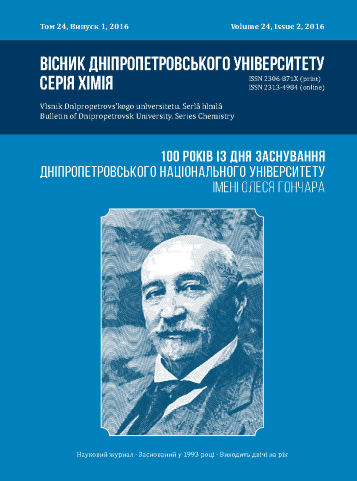Digital colorimetric determination of vitamin <em>C<em> using 18-molybdo-2-phosphate
DOI:
https://doi.org/10.15421/081614Keywords:
18-molybdo-2-phosphate, heteropoly blue, chromaticity, vitamin C, ascorbic acidAbstract
Reduction with ascorbic acid of tetraethylammonium salt of 18-molybdo-2-phosphate heteropoly complex impregnated on the filter or the chromatographic paper was investigated. Digital scan images of colored paper test strips obtained with the office scanner were resolved into R, G, and B colors. It was found that dependence of the coordinates of RGB colors on the ascorbic acid concentration is satisfactorily linearized using the equation y = yo + Aexp(–c/t). Rapid and simple colorimetric method for the determination of ascorbic acid based on its reaction with impregnated on the paper 18-MPC was developed. Method was applied to the determination of vitamin C in juices.References
Zolotov, Yu. A., Ivanov, V. M., & Amelin, V. G. (2002). [Chemical Test Methods of Analysis]. Moskow, Russian Federation: Editorial URSS (in Russian).
Zaporozhets, О. А., & Krushinskaya, Е. А. (2002). Determination of Ascorbic Acid by Molecular Spectroscopic Techniques. J. Anal. Chem., 57(4), 286–297. doi:10.1023/A:1014938011955 CrossRef
Arya, S. P., Mahajan, M., & Jain, P. (1998). Photometric Methods for the Determination of Vitamin C. Anal. Sci., 14(5), 889–895. doi:10.2116/analsci.14.889 CrossRef
Ikeda, Y. O., & Yao, K. I. (1981). US Patent No. 140675. Osaka, Japan: Shionogi & Co. Ltd.
Ordman, A. B., & Weiss, H. M. (1998). US Patent No. 709257. Scottsdale, Ariz.: Weiss, H. M.
Deneke, U., Michal, G., & Beauchamp, K. (1979). US Patent No. 920034. Mannheim-Waldhof, Fed. Rep. of Germany: Boehringer Mannheim GmbH.
Vishnіkіn, A. B., & Svinarenko, T. Ye. (2008). Ukraine Patent No. 37588. Dnipropetrovsk, Ukraine. Dnipropetrovsk National University.
Petrushina, G. A., Tsiganok, L. P., & Vishnikin, A. B. (2010). [Spectrophotometric determination of ascorbic acid by using P2Mo18O626–]. Ukr. Chem. J., 76(4), 116–122 (in Russian).
Vishnikin, A. B., Sklenařova, H., Solich, P., Petrushina, G. A., & Tsiganok, L. P. (2011). Determination of ascorbic acid with Wells-Dawson type molybdophosphate in sequential injection system. Anal. Lett., 44(1–3), 514–527. doi:10.1080/00032719.2010.500789 CrossRef
Chebotaryov, A. N., Snigur, D. V., Bevziuk, E. V., & Efimova, I. S. (2014). [The Trends Analysis of Chemical Chromaticity Method Evolution (Review)]. Metody Ob'ekty Khim. Anal. – Methods Objects Chem. Anal., 9(1), 4–11 (in Russian).
Rudakova, L. V., & Rudakov, O. B. (2015). [Determination of paracetamol and sodium salicylate using TLC, photometry and digital colorimetry]. Vestn. Voronezh. Gos. Univ.: Khim. Biol. Farm. – Proceedings of Voronezh State Univ.: Chem. Biol. & Pharm., (2), 35–41 (in Russian). Retrieved from vestnik.vsu.ru
Gorda, R., Trokhymchuk, A., & Legenchuk, O. (2014). [Colorimetric Determination of Pd(II), Rh(III), Ru(IV) on the Surface of Silica Gel Chemically Modified with Thiourea Groups]. Visn. Kyjiv Nats. Univ. im. T. Shevchenka: Khim. – T. Shevchenko Nat. Univ. of Kyiv Chem. Bull., 50(1), 41–43 (in Ukrainian). Retrieved from visnyk.chem.univ.kiev.ua
Reshetnyak, E. A., Shevchenko, V. M., Pastushkina, I. О., Zagrzewski, P. M., Bondarenko, Ya. A., Vlasova, I. V., & Ostrovskaya, V. M. (2013). [Separate sorption-spectroscopic determination of Pb(II), Mn(II), Co(II), Ni(II), Cd(II), Cu(II), Zn(II) in their mixture using the reagent indicator paper]. Visn. Khark. Nats. Univ. im. V. N. Karazina. Khim. – V. N. Karazin Kharkiv Nat. Univ. Bull.: Chem., 22(1985), 210–219 (in Russian). Retrieved from chembull.univer.kharkov.ua
Khudyakova, S. N., Kolesnikova, Е. L., & Kholodelshchikova, J. A. (2016). Visual Test and Colorimetric Determination of Gold(III) with the Use of Indicator Paper. Bulletin Dnipropetrovsk Univ. Ser. Chem., 24(1), 36–47 (in Russian). doi:10.15421/081606 CrossRef
Khudyakova, S. N., & Chmilenko, F. A. (2015). Indicator Powder and Indicator Test-Tube on the Basis of Methylsilicic Acid Immobilized with Dimercaptothiopyrone Derivatives as Test System for the Colorimetric and Visual-Test Determination of Palladium(II). Vìsn. Dnìpropetr. unìv., Ser. Hìm., 23(1), 30–39 (in Ukrainian). doi:10.15421/081505 CrossRef
Sadakane, M., & Steckhan, E. (1998). Electrochemical Properties of Polyoxometalates as Electrocatalysts. Chem. Rev., 98(1), 219–238. doi:10.1021/cr960403a CrossRef
Petrushina, G. A., Tsiganok, L. P, & Vishnikin, A. B. (2011). [Spectrophotometric determination of p-aminophenol in the presence of paracetamol by using 18-molybdodiphosphate]. Bull. Dnipropetrovsk Univ. Ser. Chem., 19(3/1), 160–164
(in Russian). Retrieved from nbuv.gov.ua
Petrushyna, G. O., & Tsiganok, L. P. (2010). Ukraine Patent No. 55028. Dnipropetrovsk, Ukraine. Oles Honchar Dnipropetrovsk National University.
Dmitrienko, S. G., Apyari, V. V., Sviridova, O. A., Badakova, S. A., & Zolotov, Yu. A. (2004). [On the new Approach to the Theory of Preferential Wetting of Heteroheneous Solid Surfaces]. Moscow Univ. Chem. Bull., 45(2), 131–138 (in Russian). Retrieved from chem.msu.su
Selivanova, T. V., Vishnikin, A. B., & Tsiganok, L. P. (2009). [Ionic Associates SiMo12O404- with Triphenylmethane Dyes in the Sorption-Colorimetric and Visual Test-Determination of Silicium]. Metody Ob'ekty Khim. Anal. – Methods Objects Chem. Anal., 4(1), 18–22 (in Russian).
Dejaegher, B., Bloomfield, M. S., Smeyers-Verbeke, J., & Vander Heyden, Y. (2008). Validation of a fluorimetric assay for 4-aminophenol in paracetamol formulations. Talanta, 75(1–2), 258–265. doi:10.1016/j.talanta.2007.11.029 CrossRef
Kristian, G. (2009). [Analitycal Chemistry (Vol. 1)]. Мoscow, Russian Federation: Binom (in Russian).
European Pharmacopeia (6th ed.) (2007). European Directorate for the Quality of Medicines (EDQM). Council of Europe, Strasbourg Cedex, France.
Downloads
Published
Issue
Section
License
Copyright (c) 2016 Oles Honchar Dnipropetrovsk National University

This work is licensed under a Creative Commons Attribution 4.0 International License.
- Authors reserve the right of attribution for the submitted manuscript, while transferring to the Journal the right to publish the article under the Creative Commons Attribution License. This license allows free distribution of the published work under the condition of proper attribution of the original authors and the initial publication source (i.e. the Journal)
- Authors have the right to enter into separate agreements for additional non-exclusive distribution of the work in the form it was published in the Journal (such as publishing the article on the institutional website or as a part of a monograph), provided the original publication in this Journal is properly referenced
- The Journal allows and encourages online publication of the manuscripts (such as on personal web pages), even when such a manuscript is still under editorial consideration, since it allows for a productive scientific discussion and better citation dynamics (see The Effect of Open Access).


